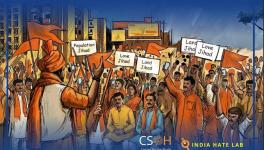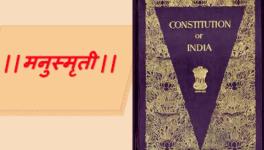BJP Romped Home on Altered Perceptions, Distorted Reading of Past
Has the BJP changed the old maxim that elections are not won by the Opposition but lost by the incumbent government? The question seems relevant considering the contrast in the fates of the Bharatiya Janata Party (BJP) in the November 1998 Assembly election in Delhi and its spectacular success in the latest round of elections in four states.
This shows that while price rise and material condition of people were the primary reasons for the voter’s choice previously and till recently—rampant inflation and the BJP’s campaign highlighting that it was a major reason for the UPA’s loss in 2014—it is not the case now.
In 1998, the Delhi government was headed by the late Sushma Swaraj, para-dropped from the Union Cabinet as chief minister two months prior to the polls. Barely seven months prior to the election, Atal Bihari Vajpayee had been sworn in as prime minister of a stable coalition government.
Yet the BJP and Swaraj were humiliated winning just 15 of the 70 seats while the Congress romped home with 52. The BJP lost because of the government’s consistently poor performance since 1993, the first election after the grant of partial statehood. The BJP failed to meet people’s expectations on issues like power, water, security, hospitals, and other basic services.
The biggest factor for the BJP’s defeat was the skyrocketing onion price, which the Vajpayee government failed to control. Post-liberalisation, Indians had not previously witnessed any party with a higher negative rating for reasons of performance—catalysed solely by the price of onion.
By the logic of 1998, the latest round of polls should have ended in a decisive defeat for the BJP if not a rout. Of various state victories, while the Congress ‘lost’ Uttarakhand more than the saffron party winning it, the BJP ended up ‘bagging’ Goa because of the division of anti-BJP votes and retained Manipur because the Congress has virtually ceased to exist.
However, the verdict in Uttar Pradesh (UP) is most significant. Even though the situation was tailormade for the BJP’s defeat, it ended up with 255 seats on its own not because the Samajwadi Party (SP) ‘lost’ the polls.
Of course, Akhilesh Yadav was a late entrant and had he entered the fray earlier, the verdict could have been somewhat different. But this should not blindside us on the capacity of the BJP to overturn negative sentiments against it by using a combination of strategies.
Of these, Narendra Modi and the party’s most spectacular success is in turning people’s gaze away from personal and collective miseries and entrapping them in the spell of a ‘civilisational’ narrative they have woven.
Inflation features negatively as a worry and an object of ridicule and shame or a worry for governments even in popular culture. In October 1974, when inflation was skyrocketing and students and the youth were agitating under the banners of Navnirmal Andolan and Total Revolution, actor-director Manoj Kumar’s film Roti, Kapada aur Makaan became a huge hit. It narrated the story of a family’s struggle for survival amid economic hardships.
“Baaki kuchh bacha to mehangai maar gayi...” (As if all this was not enough, inflation has finished me), the line from one of the movie’s songs that lists out the woes in life remains a popular refrain, an indicator that inflation is listed as possibly the biggest concern for people.
Currently, there should by all reasoning be no bigger factor than price rise and the pandemic-induced economic miseries, further aided by a clueless regime, for people to select their electoral preference.
According to the latest figures, the urban unemployment rate jumped to 12.6% in the April-June quarter of 2021 compared to 9.3% in the January-March period. Joblessness remained extremely high throughout the campaign period along with rising prices of products from fuel to fodder.
Even the Rashtriya Swayamsevak Sangh (RSS) in a resolution passed at its recent Akhil Bharatiya Pratinidhi Sabha meeting recognised for the first time in several years that more employment opportunities are required in the country.
In the run-up to the polls, common sense dictated that economic distress faced by people would challenge the BJP’s electoral dominance in the five states. These were borne out by several opinion polls. But what made common sense did not appear to make sense with the people and this remains one of the biggest paradoxes of this verdict—how the BJP became the first party in decades to retain the UP despite significant levels of despondency among people over their material conditions.
It is worth recalling that the performance of the Yadav government (2012-17) on various economic parameters was better than the Yogi Adityanath government. Despite this, why did the visible sense of despair on several fronts (even in Uttarakhand) not translate into a significantly larger anti-incumbent vote than what was behind the increased vote share of the SP?
There is no doubt that the BJP obfuscated real issues from false ones—that instead of basing their vote on the ‘present’ realities, people were lured into a dream for the future. But this vision for the future was not on basis of economic promises like Yadav did with various promises on electricity, the old pension scheme and so on.
Certainly, the BJP succeeded in getting people’s support by convincing them that their objectives were ‘more’ important than the standard development parameters which were their previous yardsticks.
In a revelatory article, RSS leader Ram Madhav pointed to three “constants” which were behind the BJP’s continuing electoral dominance despite the personal travails of people.
The first constant, according to him, is the Modi persona and his continuing popularity. While this is true to a great extent, especially at the national level in the era of presidentialisation of India’s system, it is intrinsically linked to the politics he advocates. This is accepted by Madhav, who wrote that Modi’s popularity is “not merely” because of personal charisma but also the result of his “politics”.
The second constant, according to Madhav, is the BJP-RSS organisational network.
The third constant is the most indicative of how the BJP has altered people’s perceptions and deprioritised their existence for a utopian imagination based on a distorted reading of the past.
“The third constant”, writes the former BJP general secretary, is the party’s “cultural nationalist political philosophy”. He contentiously argued that “Hindutva or cultural nationalism is neither majoritarian nor hatemongering. It is the quintessential civilisational soul of India. It resonates perfectly with the beliefs of the people of our country—hence, they identify with it”.
While disagreeing with this proposition in totality, we have to accept that people endorsed the BJP’s politics of dog whistle that emphasised law and order being more important than controlling prices and generating employment.
There is no denying that whenever BJP leaders claimed that in the past five years, criminals have been accounted for, the subliminal message was that Muslims were ‘shown their place’. This is demonstrated in the results of the post-poll survey conducted by the Centre for the Study of Developing Societies.
The following figures indicate the BJP’s success in polarising the electorate and creating a prejudice towards Muslims, the main reason for the voter’s support: 54% of Hindus voted for the BJP—up from 47% in 2017—while in contrast, only 26% of Hindus who participated in the survey pressed the ‘Cycle’ button on the EVM although their numbers were up from 19% in the previous polls in UP. This demonstrates some success in getting people to vote on economic factors but not sufficient to defeat the BJP.
Moreover, reverse polarisation, the old ‘alarm’ that the BJP has rung since 1991, worked for the party again: in seats where Muslims were 40% or upwards, 69% Hindus lined up behind the BJP.
The SP’s vote among Hindus increased in inverse proportion to the Muslim presence in constituencies—the fewer Muslims meant more Hindus voted for the SP and vice versa. This shows that ‘Muslim presence’ is being successfully harnessed by the BJP and is behind other parties being ‘forced’ to further reduce party nominations for candidates from the minority community.
The BJP success is the result of decades of a campaign rooted in the Ram Janmabhoomi agitation. This can be countered not by just a few months of campaign before polls but by being in the ‘field’ continuously and raising ideological issues, not staying mute on them.
If this is not done, people will continue agitating on economic issues—as during the farmers’ stir—but will vote on the basis of their religion, not class and occupational identities.
The writer is an NCR-based author and journalist. His latest book is ‘The Demolition and the Verdict: Ayodhya and the Project to Reconfigure India’. His other books include ‘The RSS: Icons of the Indian Right’ and ‘Narendra Modi: The Man, The Times’. He tweets at @NilanjanUdwin
Get the latest reports & analysis with people's perspective on Protests, movements & deep analytical videos, discussions of the current affairs in your Telegram app. Subscribe to NewsClick's Telegram channel & get Real-Time updates on stories, as they get published on our website.
























